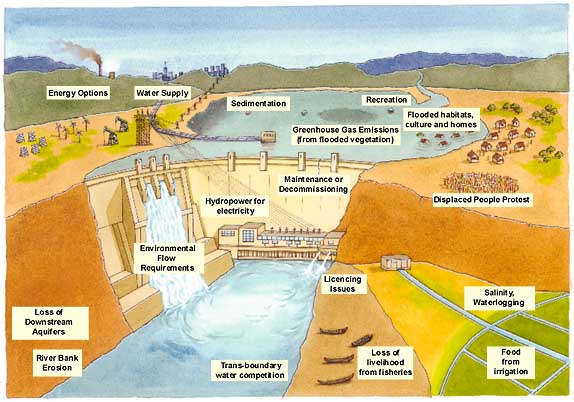geotimesheader
News Notes
Science policy
The
good, the bad and the dammed
 A
landmark report channeled the whirlpool of controversies behind dam building
and has declared large dams bigger losers. Although dams have contributed
significantly to human development, providing 19 percent of the world’s
electricity, often the costs of those achievements have hit hard on the
environment and local people, it concludes.
A
landmark report channeled the whirlpool of controversies behind dam building
and has declared large dams bigger losers. Although dams have contributed
significantly to human development, providing 19 percent of the world’s
electricity, often the costs of those achievements have hit hard on the
environment and local people, it concludes.
The World Bank, the World Conservation Union, foreign ministries and
others from polar sides on the pros and cons of building dams supported
the independent, 12-member World Commission on Dams and its report. Two
years in the making, the report offers guidelines to help build better
dams in the future. “This report provides answers and solutions,” said
former South African president Nelson Mandela, who was invited to unveil
the document in London on Nov. 16.
[Image: Diagram illustrating
the range of issues covered in the World Commission on Dams report. From
www.dams.org]
The report concluded that often the financial benefits of building a
dam have been overestimated and the ecological and social impacts ignored.
“Historically, social and environmental impacts were left outside the assessment
framework and the role of impact assessments in project selection remained
marginal, even into the 1990s,” says the report, Dams and Development:
A New Framework for Decision-Making. To date, dam building has forced up
to 80 million people worldwide from their homes.
The commission analyzed case studies of large dams from Brazil, Norway,
Pakistan, Thailand, Turkey, South Africa, Zambia, Zimbabwe and the
United States. The commission surveyed 125 other existing dams; examined
reviews from India and China; and read more than 900 solicited and unsolicited
submissions.
Although some environmentalists argue the report does not go far enough,
many found it encouraging. “The commission supports measures that would
help redress the legacy of poor performance and environmental damage from
our nation’s large dams,” Tom Graff, Environmental Defense’s California
regional director said in a statement.
Businesses also praised the findings and the guidelines of the commission.
Edward F. Carter, director of the consulting firm Harza Engineering Company
in Chicago, wrote in a letter to the editor of the Wall Street Journal
that: “The report proposes a sound approach to the future development of
a very old, yet important, water resource technology.”
Whether the guidelines will impact plans for large dams in the future,
such as the Three Gorges Dam along the Yangtze River in China, remains
to be seen. The commission’s report serves as an indictment of the decisions
made when creating dams — not of the dams themselves, says Linda Church
Ciocci, executive director of the National Hydropower Association. In a
statement, she added: “Where greater political and individual freedoms
exist, governments are accountable, and market forces are allowed to work,
development decisions of all kinds are likely to be more equitable, inclusive
and fair.”
Christina Reed
 A
landmark report channeled the whirlpool of controversies behind dam building
and has declared large dams bigger losers. Although dams have contributed
significantly to human development, providing 19 percent of the world’s
electricity, often the costs of those achievements have hit hard on the
environment and local people, it concludes.
A
landmark report channeled the whirlpool of controversies behind dam building
and has declared large dams bigger losers. Although dams have contributed
significantly to human development, providing 19 percent of the world’s
electricity, often the costs of those achievements have hit hard on the
environment and local people, it concludes.
